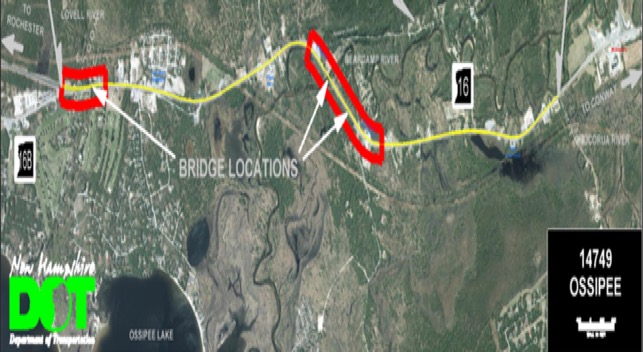Ossipee—March 25, 2019—Work will begin on Tuesday, March 26, on a major construction project to replace aging infrastructure on a long stretch of Route 16 in Ossipee. The multi-year project includes replacing three bridges, and repaving and upgrading 3.4 miles of roadway from the junction of Routes 16 and 16-B at Indian Mound, north to Ira’s Lane, which is south of the junction of Routes 16 and 25 in West Ossipee.
The state hopes to minimize delays caused by the work, but has advised that the $18 million project will take “up to three construction seasons to complete,” placing the end date in 2021.

The three bridges—one over the Lovell River and two over the Bearcamp—are focal points of the project. Built in the 1950s, they are on the state’s “Red List” of bridges “needing attention.” The state says the underlying pavement condition of the 3.2 mile stretch of highway where the bridges are located is “fair to poor,” meaning the road must also be replaced.
Route 16 is a vital transportation link in northern New Hampshire. In addition to heavy year-round use by local residents and vacationers, it is the main artery for motorists headed to the White Mountains from points south.
State officials say an average of 11,000 vehicles travel this stretch of road daily, with a peak of 18,000 daily vehicles during the peak summer season.

Replacement of the Lovell River Bridge will require construction of a temporary adjacent bridge, while a technique known as “slide-in bridge construction” will be used for the two Bearcamp River bridges. When the first traffic disruption commences on Tuesday, vehicles at one of the two Bearcamp bridges will be funneled into a single lane, with temporary traffic signals directing motorists in alternating two-way traffic flows.
Aging Infrastructure
The oldest of the three structures, the 58-foot long Lovell River Bridge was built using steel I-beam construction in 1950. The state has targeted it for replacement because its poor deck condition restricts heavy loads on the highway. Additionally, it can be covered with water when the Lovell River floods. When complete, the new Lovell River Bridge will be higher and extend to 97-feet, allowing more water to pass underneath.
The Bearcamp River bridges are newer, but not by much. Completed in 1955, they too were constructed with steel I-beams. The bridges—one 392 feet long and the other 168 feet—are also in poor condition, with deteriorating decks, girders and piles.
The new bridges over the Bearcamp will be constructed along their existing alignment, with one expanded to 410 feet and the second increased to 185 feet. Bridge piers will be removed from the river to reduce the number of spans.
Meanwhile, the rehabilitation of the roadway will include removing and replacing all existing pavement, repairing or replacing drainage, and upgrading guardrails.
The start of construction this week is the culmination of a process that began with public hearings in the fall of 2016 and stakeholder meetings in 2017. Since the Bearcamp bridges are considered historic, review of the project included consideration of Section 106 of the National Historic Preservation Act.
Additionally, the state considered the impact to rare plants and natural communities, the Northern Long-Eared Bat, Atlantic Salmon, and wetlands as part of the project evaluation process.
Complete information on the project may be found at this state webpage.
